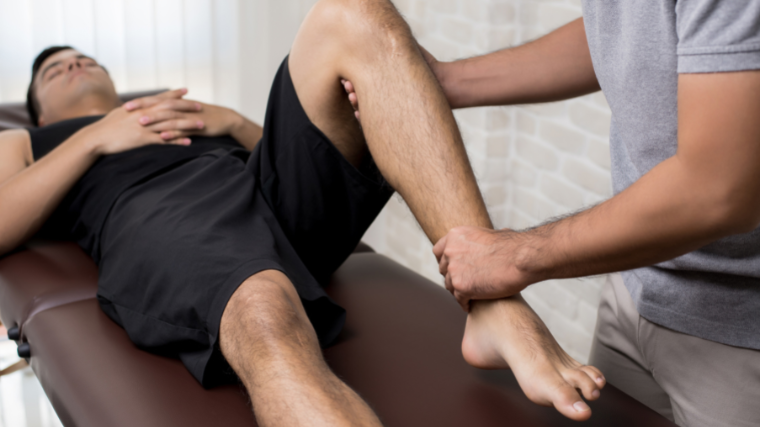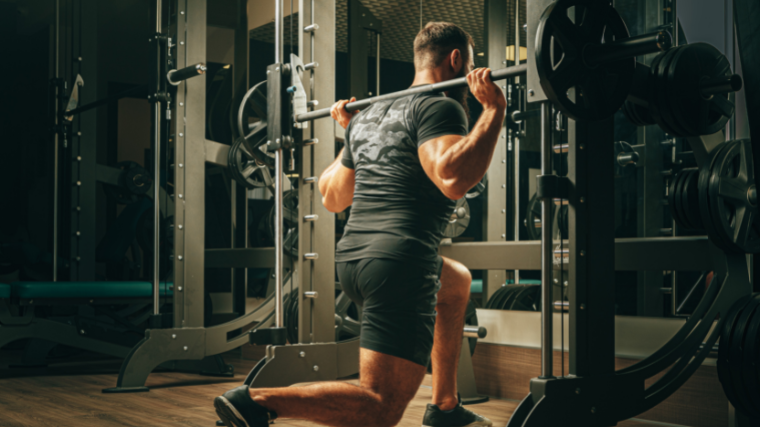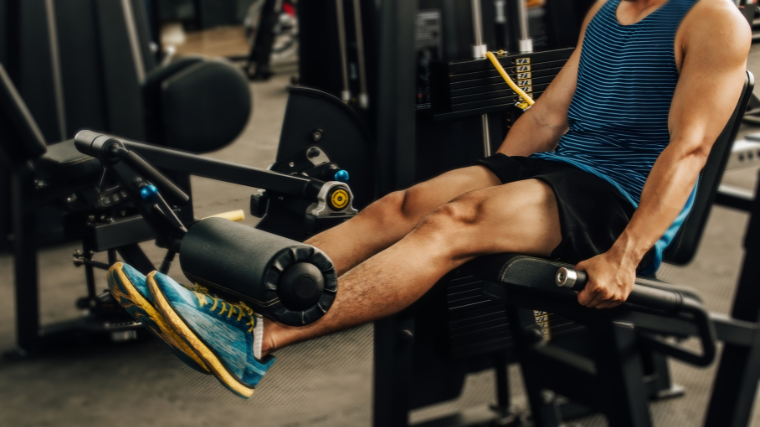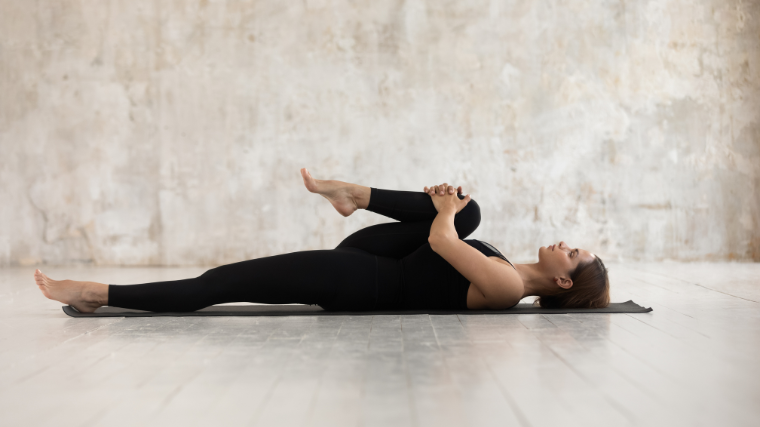You walk into the gym pain-free. After going through your trusty squat warm-up, you apprehensively unrack the bar for the first time, anxiously waiting for a spasm or shockwave to radiate across your body and let you know what kind of training day you’re in for.
Dealing with an acute injury is a precarious position to be in for any recreational (or competitive) strength athlete. Does a slipped disc or a pinched nerve herald the closure of your career in the gym? Does a back injury mean you can never squat again, or that you can no longer grow your legs?

No. While injuries — be they a twinge or tweak, or something more serious — are somewhat common in strength training, they are rarely a fatal blow to your workouts. If you’re dealing with a spine-related ailment, you may have thrown in the towel on your squats prematurely.
With the right exercises, a sound approach to program design, and a healthy amount of respect for your own limitations, leg training (and leg gains) aren’t off the table, even if you’ve got a back injury.
Editor’s Note: The content on BarBend is meant to be informative in nature, but it should not be taken as medical advice. When starting a new training regimen and/or diet, it is always a good idea to consult with a trusted medical professional. We are not a medical resource. The opinions and articles on this site are not intended for use as diagnosis, prevention, and/or treatment of health problems. They are not substitutes for consulting a qualified medical professional.
Before You Take Action
Injuries happen in sports. From calisthenics to collegiate football to Brazilian Jiu-Jitsu, athletes of all disciplines and skill levels are (mostly) certain to tweak, sprain, or pull something eventually. In that regard, weight training is no exception.
In fact, “sports illnesses”, or low-level physical ailments that affect your performance in one way or another, are astonishingly common, even in recreational weight lifting. On the other hand, catastrophic injuries that require significant medical interventions (like surgery or a cast) are quite rare. (1)

Regardless, it is imperative that you defer to a qualified medical professional if you’re worried about your health. No guide you read online, e-book you purchase, or guru you follow can properly substitute for the care provided by a physician.
If you’re currently suffering from an injury, seek guidance from your doctor before beginning any form of strenuous exercise.
What Pain Is (and Isn’t)
If you’re injured, it may feel like the doomsday clock is ticking. You may even be experiencing pain at, or around, the site of the injury. Know, though, that pain doesn’t always live up to its own reputation.
Pain Is Information
A large portion of those suffering from injuries see their pain purely as some kind of punishment, rather than what it really is — information. (2) On a biological level, a pain response is simply your body’s attempt to inform you that something is amiss. Pain is the fire alarm, not the fire itself.
Pain Isn’t (Always) a Problem
Acute pain says little about your physical health status at any given time. Instead, you can think of pain as a protective mechanism that lets you know what you should be aware of internally.
Pain reflects an apprehension of threat.
Modern research on pain science backs this, too. The supposition that acute pain is directly indicative of a serious problem is slowly changing, and much of the scientific community now appreciates a separation between physical pain and the injury itself.
A more practical way to understand pain is to think of it as a “recognizable somatic experience that reflects a person’s apprehension of threat to their bodily or existential integrity.” (3)
Pain Is Temporary
Pain is transient. While you’re more likely to experience significant pain in the hours and days directly following an accident like a missed squat or deadlift attempt, you probably aren’t going to be saddled with discomfort permanently.
Your timescale when recovering from a back injury will vary, as will the levels of pain you experience over that period. (4)
Often, there’s no rhyme or reason to when you’re in pain or aren’t, and it may not even directly correlate to your behaviors in or out of the gym. Don’t become too wary of your current levels of pain and lose sight of the big picture.
The most important thing to remember is that, as long as you take time to properly heal and recover, you’re not going to be in pain forever.
Pain Isn’t Accurate
Experiencing acute or chronic pain is not always a useful form of information for athletes. In fact, the opposite can be true.
A surprisingly large percentage of athletes who suffer from disc-related ailments experience no adverse symptoms at all. (5) Conversely, it’s possible that the “source” of your pain isn’t actually coming from the compromised joint or tissue, but as a byproduct of neurological or even environmental factors. (6)
If you are experiencing pain, know that it doesn’t necessarily correlate to the actual physical status of where you’re at with your health. However, that also doesn’t mean you should discard the information your body gives you.
Should You Train While Injured?
To get to the heart of the issue, you need to make an informed decision about whether you should be stepping into a squat rack at all if you’ve got an injury. Fortunately, most research indicates that the answer is “yes.”
Training Helps Outside the Gym
Injuries can be a real dampener to your mood and motivation. Those who suffer from an injury, be it mild or severe, are more likely to be a bit lax about their health outside the weight room.

This can take the form of poor dietary adherence, increased alcohol consumption, or subpar sleep hygiene. As such, even if you’ve tweaked something, continuing to train can help provide structure to your health habits. (1)
Training Accelerates Recovery
It’s not groundbreaking, but it absolutely bears mentioning that lifting weights is restorative. As long as you keep your intensity, volume, and frequency in check, and don’t try to do too much at once, your leg workouts can have a positive impact on how quickly you bounce back from an injury. (7)
Training Makes You Feel Better
Similarly to being physically rehabilitative, resistance training can also assist with the mental rigors of battling an injury. (7)
Physically going to the gym and working through resistance-based or calisthenic movements can be a huge boon to your mood and mindset, as well as serve as an effective reminder that you’re not “broken.”
“Exercise increases blood flow, helping to shuttle inflammatory chemicals and waste products,” says Dr. Zachary Long, Doctor of Physical Therapy and owner of The Barbell Physio. “Further, physical activity also releases endorphins, which have a pain-relieving effect all their own.”
Training Isn’t Always Useful
Although continuing to lift while injured may be the right move, you should not necessarily rush back into your strength program right after an accident.
Your body will be very honest with you about whether or not you can tolerate lifting weights. A bit of discomfort here and there is one thing, but if you’re in noticeable pain during — or even before — your warm-up sets, you’re probably doing more harm than good.
Listen to your body and, more importantly, the word of your physician before you decide to get active.
How to Train Legs While Injured
Training through an injury isn’t as simple as going through your regular workout with a bit less weight, but it isn’t all that complicated either. You can still get a banger of a leg day in as long as you take the right precautions.
Step 1 — Find Your Baseline
Step one when trying to train legs under the duress of injury is to assess where you’re at. You need to accurately determine what your tolerance is to exercise so you know how hard you can work safely.
To do this, start from the ground, literally, and work your way up. If you can do a dead bug on the floor, you know you can flex and extend your leg safely. From there, move on to a bodyweight squat. If that’s clear, grab a dumbbell and test your tolerance to goblet squats, and so on.
Research indicates that resistance training is particularly effective at preventing “deconditioning” and managing your sensitivity to pain. (8)
If you take things too easily in the gym, you might inadvertently set yourself up to be too reactionary to any stray sensations that you’d normally not notice.
Step 2 — Warm-Up Thoroughly
Warm-ups are crucial for performing well in the gym, whether you’re injured or not. That said, the literature hasn’t conclusively determined if a pre-exercise warm-up demonstrably reduces your risk of acute, activity-related injury. (9)
Regardless, a good warm-up can help in other ways. Increasing your core temperature, inspiring some movement confidence, and gradually exposing yourself to more difficult challenges all help ensure you’re properly prepared to train.
Step 3 — Modify Your Movements (as Needed)
You aren’t married to any one movement in the weight room — even if you’re a career powerlifter. Working around a spine injury might mean passing up on back squats for a friendlier alternative.
For instance, plenty of literature points to front squats or goblet squats as a viable back-friendly substitute. (10) You’ll generally find that the more horizontal distance there is between your lower back and the weight you’re working with, called a moment arm, the harder it is on your spine.
As such, exercises like the trap bar deadlift may be a comfortable replacement for barbell pulling, while the goblet or belt squat might allow you to squat with little to no pain at all.
Your relationship with movement is highly individual, and will likely take a bit of trial-and-error.
Back-Friendly Leg Exercises
No two bodies (or injuries, for that matter) are the same. As such, your personal relationship with a given exercise may not be the same as your gym partner’s. What should be a “safe” leg exercise on paper might cause you pain, stress, or anxiety.
Regardless, the following leg exercises should allow you to train with a reasonable degree of comfort, depending on the specific nature of your injury. These movements are in no way recommended as treatment for an injury — they should serve as a solid way to work back into training.
Belt Squat
Most squatting movements are loaded axially, meaning the weight rests on the spine and creates compressive force. If you have a disc or soft tissue injury, spinal compression may trigger a painful response.
The belt squat lets you perform a deep squat, but instead of the weight pushing down on your skeleton from above, it pulls on your hips from below, creating traction.
While spinal traction isn’t a well-backed treatment for back pain, (11) from a mechanical standpoint the belt squat creates much less tension on your spine than a back or front squat would.
Box Squat
It’s possible that you only get a flare-up or jolt of pain when working in a specific range of motion. If two-thirds of your squat feels great, but you can’t sink “ass to grass” as you normally do, you can bring a box into the equation.
Box squats are a very straightforward way of turning the squat into a partial-range-of-motion movement. By firmly limiting how deep you can squat, you can still train hard and heavy without worrying that you’ll accidentally wander into a painful range.
Tempo Squat
If you’re experiencing low back pain, you likely rely more on your core musculature than you otherwise would. (12) As such, properly bracing and engaging your abs during compound leg movements is of the utmost importance.
Tempo training allows you to do just that. By increasing the duration of your eccentric movement, you give yourself enough time to focus on maintaining proper technique and a snug and secure brace.
Long echoes this idea, stating that tempo work helps make light weights feel heavy, which may allow you to get a solid training stimulus without incurring pain.
Goblet Squat (Standard or 1 & 1/2-Rep)
Anterior, or front-loaded squats, place less of a mechanical demand on your lower back and hips compared to your upper back and core. As such, a goblet squat with a dumbbell (or kettlebell) is a great starting movement if you’re training with an injury.
Not only should the goblet squat help you maintain an upright torso and solid brace, but the nature of the exercise also allows you to safely and rapidly exit the set if you feel a moment of pain or discomfort. Simply let go of the weight and you’re out of there.
Long strongly endorses one-and-a-half-rep schemes for movements like the goblet squat as they, “significantly increase your time under tension to train your quads without requiring that you use a heavy weight.”
Hip Thrust
Training your posterior chain is just as (if not more) important than building your quads, but most glute and hamstring movements also place a great deal of stress on the lumbar spine.
The hip thrust is a rare exception. With proper technique, the hip thrust places nearly all of its load directly onto the glutes and hamstrings, sparing your spine.
Step-Up
If you’re injured, it’s quite common to have one side of your body pick up the slack to account for any weakness around the site of the injury. This is a valuable protective mechanism, but it may also lead to imbalances in strength or posture.
To that end, unilateral exercises like the step-up can serve as an effective means of treating side-to-side disparities that may contribute to, or worsen, back pain. (13)
From a practical standpoint, single-leg step-ups are easy to perform, require little to no external weight to be effective, and allow you to cease the exercise immediately if you begin experiencing discomfort.
Machine Movements
You don’t need to rely on free weights to gain muscle. While often considered useful only for rank beginners, weight machines can be incredibly useful if you’re training around an injury.
The fixed path of movement, high degree of external stability, and unique loading parameters make machines like the leg extension, leg curl, or hip abduction indispensable when you can’t rely on your usual sets of squats and deadlifts.

Consider making machine isolation exercises a larger portion of your overall training volume if you’re unable to use heavy free-weight compound lifts.
Sample Back-Friendly Leg Workout
One of the worst things you can do while working through a back injury is to follow a pre-written program that doesn’t account for your specific needs.
That said, a sample back-friendly leg day can also serve as a solid visualization of the principles you should rely on while training your legs. This workout by no means guarantees safe passage through an injury, but it does put many of the principles mentioned above into practice.
The Workout
This workout starts slowly and builds on itself, allowing you to pause, adjust, or exit out at any point. You’ll also notice a great deal of machine work to account for lower time spent with the barbell.
- Warm-Up: 5-10 minutes on the treadmill or stair stepper.
- 90-90 Breathing Drill: 2 rounds of 10 breaths.
- Dead Bug or Bear Plank: 3 x 20 seconds.
- Tempo Goblet Squat: 2 x 5
- Belt Squat: 3 x 8-10
- Hip Thrust: 2 x 12-15
- Leg Extension: 4 x 12-15
- Leg Curl: 4 x 12-15
- Cable Glute Kickback: 2 x 15
How to Progress With a Back Injury
Spinal trauma doesn’t mean you have to forsake all forms of progress in the gym. It just might mean a brief break from trying to set a new personal record in the squat.
Instead of catastrophizing over any possible loss of strength or size, you can turn your gaze elsewhere and make the most of any “downtime” in the gym.
Make Use of Machines
Hypertrophy is driven by a combination of mechanical tension, muscle damage, and metabolic stress. You can get all three in spades from heavy squats, sure, but you can still build an impressive amount of muscle with machines and cable stations as well.
If you’re managing an injury that necessitates less time in the squat rack, you can make up for that lost stimulation by increasing your total sets, reps, or weight on leg machines or via isolation exercises.
Focus on Form
A physical malady that prevents you from lifting heavy does come with a silver lining. If you can’t work at high intensities, your only option is to do a lot with a little — which means giving extra attention to your technique.
Taking a step back from heavy leg training provides you an opportunity to lace up your form on lighter squats, pulls, or their variations. That attention to detail should pay off when you return to your normal workouts down the line.
Get Flexible
If your injury bans you from the barbell entirely, “proper” leg workouts may be temporarily off the table. In the event that you’re able to be physically active but have a low tolerance for external resistance, you can refocus your efforts toward mobility and loadless movements instead.

Aerobics, calisthenics, and dynamic stretching all induce positive biological effects that can impact your rate of recovery from injury. (14) Moreover and in almost all cases, any movement at all is better than none if you’re nursing a tweaked back.
Work on your hip, knee, ankle, or upper back mobility while you’re waiting to return to the weights, and you’ll move better once you get there.
Take Small Wins
Healing a back injury (or any medical issue, for that matter) isn’t a switch that you flip. You won’t go from being in daily pain to flawless and free movement overnight, even if your recovery is on point.
As such, make a note of every small bit of progress you make. Whether that’s feeling excited rather than anxious about going to the gym, sticking to your at-home stretching or rehab routine for a full week, or hitting more low or pain-free reps than you did the session prior.
Forward momentum and a positive outlook can have a tangible, real-world impact on injuries. The placebo effect won’t cure you, but it can quite literally reduce mental — and physical — anguish. (15)
Movement Is Medicine
Injuries suck, plain and simple. While some in the iron game wear their sprains and slipped discs as a badge of honor or something they’ve “earned” by training long enough, the reality is far less glamorous.
Injuries derail your progress, deter your motivation, and dampen your enthusiasm for what should be a fulfilling and enjoyable activity. On the upside, they’re also not permanent, nor do injuries sentence you to mediocrity in the gym.
Pain science and rehabilitation practices have evolved past the “rest and ice it” prescription of years past. Any serious injury requires supervision by a qualified medical professional, but your journey back to the barbell should also involve the barbell itself.
Train conservatively, take it slow, listen to your doctor or physical therapist, and you’ll be back in fighting shape before you know it.
References
1. Strömbäck, E., Aasa, U., Gilenstam, K., & Berglund, L. (2018). Prevalence and Consequences of Injuries in Powerlifting: A Cross-sectional Study. Orthopaedic journal of sports medicine, 6(5), 2325967118771016.
2. Bunzli, S., Smith, A., Schütze, R., Lin, I., & O’Sullivan, P. (2017). Making Sense of Low Back Pain and Pain-Related Fear. The Journal of orthopaedic and sports physical therapy, 47(9), 628–636.
3. Cohen, M., Quintner, J., & van Rysewyk, S. (2018). Reconsidering the International Association for the Study of Pain definition of pain. Pain reports, 3(2), e634.
4. Zhao, R. T., Kandil, A., Nguyen, D. V., Campos, L., Amin, N. H., & Chang, E. Y. (2020). Pain Perception in Taekwondo: Relationship to Injury, Experience, and Time Loss. Sports medicine international open, 4(2), E53–E58.
5. Brinjikji, W., Luetmer, P. H., Comstock, B., Bresnahan, B. W., Chen, L. E., Deyo, R. A., Halabi, S., Turner, J. A., Avins, A. L., James, K., Wald, J. T., Kallmes, D. F., & Jarvik, J. G. (2015). Systematic literature review of imaging features of spinal degeneration in asymptomatic populations. AJNR. American journal of neuroradiology, 36(4), 811–816.
6. Fillingim R. B. (2017). Individual differences in pain: understanding the mosaic that makes pain personal. Pain, 158 Suppl 1(Suppl 1), S11–S18.
7. Welch, N., Moran, K., Antony, J., Richter, C., Marshall, B., Coyle, J., Falvey, E., & Franklyn-Miller, A. (2015). The effects of a free-weight-based resistance training intervention on pain, squat biomechanics and MRI-defined lumbar fat infiltration and functional cross-sectional area in those with chronic low back. BMJ open sport & exercise medicine, 1(1), e000050.
8. Vuori I. M. (2001). Dose-response of physical activity and low back pain, osteoarthritis, and osteoporosis. Medicine and science in sports and exercise, 33(6 Suppl), S551–610.
9. Soligard, T., Myklebust, G., Steffen, K., Holme, I., Silvers, H., Bizzini, M., Junge, A., Dvorak, J., Bahr, R., & Andersen, T. E. (2008). Comprehensive warm-up programme to prevent injuries in young female footballers: cluster randomised controlled trial. BMJ (Clinical research ed.), 337, a2469.
10. Yavuz, H. U., Erdağ, D., Amca, A. M., & Aritan, S. (2015). Kinematic and EMG activities during front and back squat variations in maximum loads. Journal of sports sciences, 33(10), 1058–1066.
11. Alrwaily, M., Almutiri, M., & Schneider, M. (2018). Assessment of variability in traction interventions for patients with low back pain: a systematic review. Chiropractic & manual therapies, 26, 35.
12. Seyed Hoseinpoor, T., Kahrizi, S., Mobini, B., & Naji, M. (2015). A comparison of abdominal muscle thickness changes after a lifting task in subjects with and without chronic low-back pain. Human factors, 57(2), 208–217.
13. Yoo W. G. (2016). Effect of unilateral exercises on low back pain in an urban driver. Journal of physical therapy science, 28(11), 3257–3258.
14. Gordon, R., & Bloxham, S. (2016). A Systematic Review of the Effects of Exercise and Physical Activity on Non-Specific Chronic Low Back Pain. Healthcare (Basel, Switzerland), 4(2), 22.
15. Rossettini, G., Carlino, E., & Testa, M. (2018). Clinical relevance of contextual factors as triggers of placebo and nocebo effects in musculoskeletal pain. BMC musculoskeletal disorders, 19(1), 27.
Featured Image: Srdjan Randjelovic / Shutterstock
The post How to (Safely) Train Legs if You Have a Back Injury appeared first on BarBend.

